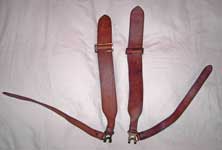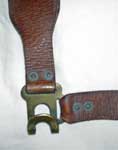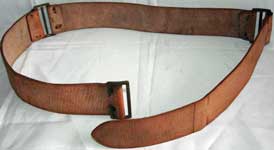Pattern 1939 Leather Infantry Equipment
Belts, Braces, and Straps
Pattern 1914 Leather Infantry Equipment employed brass fittings that dated back to Victorian times. Pattern 1939 Leather Infantry Equipment - let’s ascribe a derived nomenclature – utilised the standard M.E.Co. brass buckles. In place of stitching, thereby simplifying the manufacturing process, Hose Rivets were used throughout the Pattern.


 These were of the Patt. ’37 form, reproduced in leather, the sections riveted together. The gateleg buckle being too difficult to manipulate with a leather belt, a simple riveted loop was substituted. Unlike the Patt. ’14 Attachment, brace, no Steadying Hook was fitted to the belt loop.
These were of the Patt. ’37 form, reproduced in leather, the sections riveted together. The gateleg buckle being too difficult to manipulate with a leather belt, a simple riveted loop was substituted. Unlike the Patt. ’14 Attachment, brace, no Steadying Hook was fitted to the belt loop.
The upper section comprised a single, short length of 1-inch leather strapping, doubled around a Buckle, brass, 1 inch, with loop (a 4-bar buckle) and the Link, brass, oval, 1 inch that was used on Patt. ’37 Carriers, cartridge. Four hose rivets were paired just below the buckle and just above the Link. A second length was doubled for almost its full-length, the lower part closed into a belt loop with paired hose rivets, with a single rivet half way between the belt loop and brass Link. At its upper extremity, the front strap was doubled around the Link and rivetted at the back, with a pair of hose rivets. From the Ed Storey Collection, photographs © Ed Storey 2010.
Belt, waist, large
Belt, waist, small
 The lineage of the belt stretches back to a Victorian design concept, seen in Valise Equipent, Patterns 1882 and 1888, then repeated in Pattern 1914 Leather Infantry Equipment. As in the latter Pattern, a single piece of leather was adjustable at each side, with a Buckle, brass, waist belt, 1 7/8-in.- a Victorian design. This was a narrow loop, fitted with a short, loose tongue, which fitted into punched holes on the centre-line of the belt. The resulting belt was therefore narrower, but meant that a stock fitting could be used. The “hook and loop” buckle – made for 2 1/4-inch web belts - was therefore visibly over-sized. Leather runners were substituted for the Slides, brass of the Patt. ’37 Belt. The back buckles were the gated 3-bar type, on riveted chapes, where Patt. ’37 used un-gated 3-bar buckles. From the Tom Ready Collection. Photo © Tom Ready, 2010.
The lineage of the belt stretches back to a Victorian design concept, seen in Valise Equipent, Patterns 1882 and 1888, then repeated in Pattern 1914 Leather Infantry Equipment. As in the latter Pattern, a single piece of leather was adjustable at each side, with a Buckle, brass, waist belt, 1 7/8-in.- a Victorian design. This was a narrow loop, fitted with a short, loose tongue, which fitted into punched holes on the centre-line of the belt. The resulting belt was therefore narrower, but meant that a stock fitting could be used. The “hook and loop” buckle – made for 2 1/4-inch web belts - was therefore visibly over-sized. Leather runners were substituted for the Slides, brass of the Patt. ’37 Belt. The back buckles were the gated 3-bar type, on riveted chapes, where Patt. ’37 used un-gated 3-bar buckles. From the Tom Ready Collection. Photo © Tom Ready, 2010.
Braces, left and right, normal
Braces, left and right, long


 The shape was a repeat of the Patt. ’14 form, with 1-inch sections smoothly blended to 2-inch shoulder flares, but without any holes punched at their ends, or rear shoulder section. The left-hand Brace had a cross-over loop rivetted to it, but on its outside face, unlike Patt. ’37. Eventually, Braces, long were introduced, the existing Braces becoming Normal, as with Patt. ’37. This pair are maker marked "S.C. & Co. Ltd." and dated 1941. From the Chris Pollendine Collection, photos © Chris Pollendine 2010.
The shape was a repeat of the Patt. ’14 form, with 1-inch sections smoothly blended to 2-inch shoulder flares, but without any holes punched at their ends, or rear shoulder section. The left-hand Brace had a cross-over loop rivetted to it, but on its outside face, unlike Patt. ’37. Eventually, Braces, long were introduced, the existing Braces becoming Normal, as with Patt. ’37. This pair are maker marked "S.C. & Co. Ltd." and dated 1941. From the Chris Pollendine Collection, photos © Chris Pollendine 2010.
Straps, haversack, left and right

 The strap ends have pointed ends on both 2- and 1-inch strapping and the shoulder flare is smoothly tapered, in the manner of Patt. ’14 Braces. In all other respects they were exactly as the Patt. ’37 form and used the same Hooks, haversack, brass. A Buckle, brass, 2-in. was fitted to each, this being identical to Patt. ’37 and not the tongued version used on Patt. ’14. From the Chris Pollendine Collection, photos © Chris Pollendine 2010.
The strap ends have pointed ends on both 2- and 1-inch strapping and the shoulder flare is smoothly tapered, in the manner of Patt. ’14 Braces. In all other respects they were exactly as the Patt. ’37 form and used the same Hooks, haversack, brass. A Buckle, brass, 2-in. was fitted to each, this being identical to Patt. ’37 and not the tongued version used on Patt. ’14. From the Chris Pollendine Collection, photos © Chris Pollendine 2010.
 Once again, this was the Patt. ’08 form, but reproduced in leather. This pair are maker marked "J.B.B." and dated 1941. From the Tom Ready Collection. Photo © Tom Ready, 2010
Once again, this was the Patt. ’08 form, but reproduced in leather. This pair are maker marked "J.B.B." and dated 1941. From the Tom Ready Collection. Photo © Tom Ready, 2010

![]()
![]() Having written this up as “No example has been noted” – along came not one, but three! We are indebted to Chris Pollendine for a fortuitous purchase of something he thought unusual. This was a belt, made up of three sections, joined together with two Buckles, brass, 2-in., with a third example acting as the belt buckle proper. Each section was about 16-inches long and 2-inches wide. The extremities, evidently once pointed, had been cut-off, doubled round the outside bars of the dividing 2-inch buckles and secured by a pair of bifurcated rivets. Fortunately, the running end of the “belt” retains its pointed end intact. All edges are tooled, but it was obvious that no “flares” had been cut-off the edges. What we were looking at were Patt. ’39 Utility Pouch Yokes – the proverbial swords turned into ploughshares. The picture far left shows the belt as found. The two photos centre and near left show KW's reconstruction of the Yoke in its original form, cleverly CGIed by Chris P.
Having written this up as “No example has been noted” – along came not one, but three! We are indebted to Chris Pollendine for a fortuitous purchase of something he thought unusual. This was a belt, made up of three sections, joined together with two Buckles, brass, 2-in., with a third example acting as the belt buckle proper. Each section was about 16-inches long and 2-inches wide. The extremities, evidently once pointed, had been cut-off, doubled round the outside bars of the dividing 2-inch buckles and secured by a pair of bifurcated rivets. Fortunately, the running end of the “belt” retains its pointed end intact. All edges are tooled, but it was obvious that no “flares” had been cut-off the edges. What we were looking at were Patt. ’39 Utility Pouch Yokes – the proverbial swords turned into ploughshares. The picture far left shows the belt as found. The two photos centre and near left show KW's reconstruction of the Yoke in its original form, cleverly CGIed by Chris P.
Bren Gun magazines being a great deal lighter than Lewis Gun drums, a 2-inch bearing surface was quite sufficient. Until seeing these examples, it had been thought that the webbing Brace, pouch, Lewis gun, web Yoke for the Pouches, Magazine, Lewis gun, web was used. This is now seen as coincidental compatibility. From the Chris Pollendine Collection. Photographs © Chris Pollendine 2010.
Rog Dennis, December, 2010